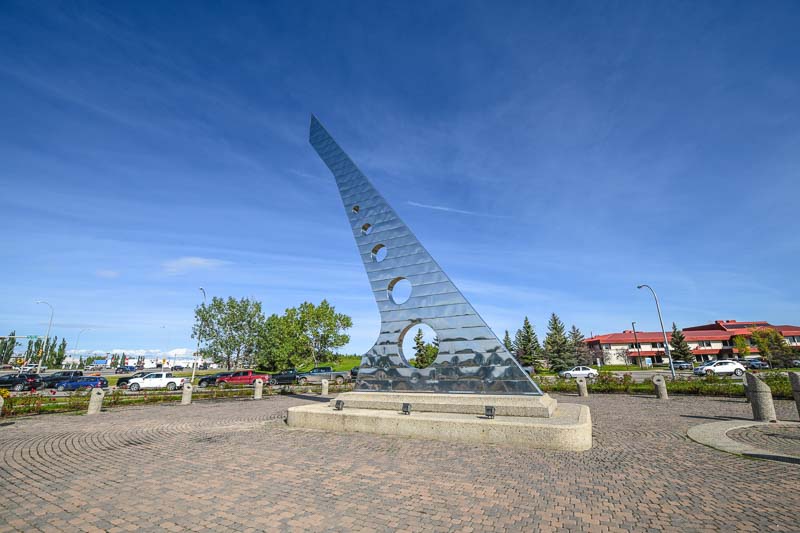Grande Prairie, Alberta, Canada
Grande Prairie is a city in northwestern Alberta, Canada, located near the southern extremity of Peace River Country. In terms of physical boundaries, Grande Prairie is situated at an intersection of Highways 43 and 40 (part of the CANAMEX Corridor), which are approximately 456 km (283 mi) northwest and west of Edmonton, respectively. The City of Grande Prairie No. 1 surrounds it. With the exception of one small portion in the southeast, its boundaries follow natural features such as rivers and lakes.
With a population of 63,166 in 2016, Grande Prairie was Alberta’s seventh-largest city. Between 2001 and 2006, it was one of Canada’s fastest-growing cities. The city chose the trumpeter swan as a symbol since it is near the bird’s migration route and summer nesting sites. As a result, Grande Prairie is sometimes known as the “Swan City.” Due to paleontological discoveries in the northern and western parts of Grande Prairie, the dinosaur has become an unofficial city icon.
Grande Prairie got its name from the enormous grassland that stretched to the east, north, and west. This city is one of the major centers of economic activity in Canada, serving as a commercial center for the region. Agriculture, oil and natural gas, lumbering, and the medical sector are all important to its economy, and Grande Prairie has a sizable petrochemical industry.
Many individual communities surround the city. Among these are Beaverlodge, Hythe, Valleyview, Fairview, Hughenden, Spirit River, Sexsmith, and Wembley. The Grande Prairie-Smoky Hill communities are in development, and over half the region’s population lives in the Greater Grande Prairie area.
Growth within the city limits is influenced by proximity to the Grande Prairie Airport and the availability of land in annexed or nearby communities.
History
 Grande Prairie’s area was formerly known as Buffalo Plains, owing to the buffalo who frequently traveled across the vast prairie to the north, east, and west of it. La Grande Prairie became the first name for the region credited to Father Grouard, a Roman Catholic priest. The prairie was home to bands of the Dane-zaa (Beaver) peoples in the 18th century, who engaged in trade with the North West Company at Dunvegan. Trader Samuel Black made the earliest recorded mention of the prairie in 1824.
Grande Prairie’s area was formerly known as Buffalo Plains, owing to the buffalo who frequently traveled across the vast prairie to the north, east, and west of it. La Grande Prairie became the first name for the region credited to Father Grouard, a Roman Catholic priest. The prairie was home to bands of the Dane-zaa (Beaver) peoples in the 18th century, who engaged in trade with the North West Company at Dunvegan. Trader Samuel Black made the earliest recorded mention of the prairie in 1824.
In 1880, as a result of the Hudson Bay Company-North West Company conflict centered on Dunvegan, George Kennedy established a Hudson’s Bay Company post called La Grande Prairie 21 kilometers (13 miles) north of the current city of Grande Prairie near what is now the Town of Sexsmith.
The prairie was inhabited by Cree and Iroquois people from around Jasper and Lac Ste. Anne in the late 1800s. A land rush ensued soon after 17 townships were surveyed for homesteading in 1909, with many settlers coming via the Edson Trail. The Grande Prairie Townsite was divided in 1910. By 1912, it boasted a bank, hotel, post office, and land office, which made it a district metropolis. It became the end station of the Edmonton, Dunvegan, and British Columbia Railway from Edmonton in 1916.
Grand Prairie was founded as a city in 1958, with a population of approximately 7,600 people. Between 2001 and 2006, Grande Prairie was one of Canada’s fastest-growing cities, increasing from 37,000 to 47,000 people. After 2006, when the economy fell again, the population decreased somewhat before recovering to over 69,000 by 2018.
Our Services in Grande Prairie, Alberta, Canada
Popular Attractions in Grande Prairie
According to Tourism Grande Prairie, there are many popular tourism activities in Grande Prairie. Among these are breathtaking views at Two Lakes Provincial Park, hiking trails in Willmore Wilderness Park, or playing a game of golf in The Dunes Golf & Winter Club. The Grande Prairie Museum is another tourist attraction that features old buildings and equipment from Alberta’s past.
Tourists can visit the famous Art Gallery of Grande Prairie, which is the only fine arts museum in northern Alberta. The gallery contains various artworks such as paintings and prints by local artists, sculptures created from locally found materials like steel oil tanks and aluminum soft drink cans, photographs of unique buildings in Grande Prairie, folk art replicas of native Canadian totems, and historical artifacts. Eastlink Centre is a multi-use facility where concerts, sports events, and indoor car shows are held, and the majestic dome of the building is a popular attraction in its own right.
There are more attractions within the city that people can visit. To learn more about Grande Prarie, you can visit their website here.

